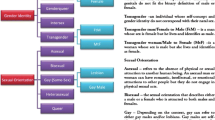Abstract
We are pleased that the thoughtful commentaries on Wood and Eagly’s (2015) review accepted our distinction between gender identity research involving personality traits and research involving self-categorization into female or male groups. Although Schmader and Block (2015) argued that self-categorization is the clearer, more fundamental approach, we maintain instead that gender identities encompass both explicit categorization of self and the less explicit endorsement of gender-typical traits. In essence, the trait and categorization analyses are two sides of the same gender identity coin. We also largely agree with Keener’s (2015) and Mehta’s (2015) illustrations of the highly multidimensional and contextualized nature of gender identity.
Similar content being viewed by others
References
Ajzen, I., & Fishbein, M. (2005). The influence of attitudes on behavior. In D. Albarracín, B. T. Johnson, & M. P. Zanna (Eds.), The handbook of attitudes (pp. 173–221). Mahwah: Lawrence Erlbaum Associates.
Bem, S. L. (1974). The measurement of psychological androgyny. Journal of Consulting and Clinical Psychology, 42, 155–162. doi:10.1037/h0036215.
Cuddy, A. J. C., Wolf, E. B., Glick, P., Crotty, S., Chong, J., & Norton, M. I. (2015). Men as cultural ideals: Cultural values moderate gender stereotype content. Journal of Personality and Social Psychology, 109, 622–635. doi:10.1037/pspi0000027.
Eagly, A. H., & Chaiken, S. (1993). The psychology of attitudes. Orlando: Harcourt Brace Jovanovich.
Eagly, A. H., & Wood, W. (2012). Social role theory. In P. A. M. Van Lange, A. W. Kruglanski, & E. T. Higgins (Eds.), Handbook of theories in social psychology (Vol. 2, pp. 458–476). Thousand Oaks: Sage. doi:10.4135/9781446249222.n49.
Ely, R. J. (1995). The power in demography: Women’s social constructions of gender identity at work. Academy of Management Journal, 38, 589–634. doi:10.2307/256740.
Frieze, I. H., & Chrisler, J. C. (2011). Editorial policy on the use of the terms “sex” and “gender”. Sex Roles, 64, 789–790. doi:10.1007/s11199-011-9988-2.
Funder, D. C. (2006). Towards a resolution of the personality triad: Persons, situations, and behaviors. Journal of Research in Personality, 40, 21–34. doi:10.1016/j.jrp.2005.08.003.
Keener, E. (2015). The complexity of gender: It is all that and more…in sum, it is complicated. Sex Roles. doi:10.1007/s11199-015-0542-5.
Koenig, A. M., & Eagly, A. H. (2014). Evidence for the social role theory of stereotype content: Observations of groups’ roles shape stereotypes. Journal of Personality and Social Psychology, 107, 371–392. doi:10.1037/a0037215.
Kozee, H. B., Tylka, T. L., & Bauerband, L. A. (2012). Measuring transgender individuals’ comfort with gender identity and appearance development and validation of the Transgender Congruence Scale. Psychology of Women Quarterly, 36, 179–196. doi:10.1177/0361684312442161.
Liben, L. S. (2014). The individual ↔ context nexus in developmental intergroup theory: Within and beyond the ivory tower. Research in Human Development, 11, 273–290. doi:10.1080/15427609.2014.967048.
Mehta, C. M. (2015). Gender in context: Considering variability in Wood and Eagly’s traditions of gender identity. Sex Roles. doi:10.1007/s11199-015-0535-4.
Schmader, T., & Block, K. (2015). Engendering identity: Toward a clearer conceptualization of gender as a social identity. Sex Roles. doi:10.1007/s11199-015-0536-3.
Sinclair, S., Hardin, C. D., & Lowery, B. S. (2006). Self-stereotyping in the context of multiple social identities. Journal of Personality and Social Psychology, 90, 529–542. doi:10.1037/0022-3514.90.4.529.
Smedley, J. W., & Bayton, J. A. (1978). Evaluative race–class stereotypes by race and perceived class of subjects. Journal of Personality and Social Psychology, 36, 530–535. doi:10.1037/0022-3514.36.5.530.
Spence, J. T., & Helmreich, R. L. (1978). Masculinity & femininity: Their psychological dimensions, correlates, and antecedents. Austin: University of Texas Press.
Spence, J. T., Helmreich, R. L., & Holahan, C. K. (1979). Negative and positive components of psychological masculinity and femininity and their relationships to self-reports of neurotic and acting out behaviors. Journal of Personality and Social Psychology, 37, 1673–1682. doi:10.1037/0022-3514.37.10.1673.
Steinmetz, J., Bosak, J., Sczesny, S., & Eagly, A. H. (2014). Social role effects on gender stereotyping in Germany and Japan. Asian Journal of Social Psychology, 17, 52–60. doi:10.1111/ajsp.12044.
Tajfel, H. (1981). Human groups and social categories: Studies in social psychology. Cambridge: Cambridge University Press.
Tobin, D. D., Menon, M., Menon, M., Spatta, B. C., Hodges, E. V., & Perry, D. G. (2010). The intrapsychics of gender: A model of self-socialization. Psychological Review, 117, 601–622. doi:10.1037/a0018936.
Williams, J. E., & Best, D. L. (1990). Sex and psyche: Gender and self viewed cross-culturally. Thousand Oaks: Sage.
Witt, M. G., & Wood, W. (2010). Self-regulation of gendered behavior in everyday life. Sex Roles, 62, 635–646. doi:10.1007/s11199-010-9761-y.
Wood, W., & Eagly, A. H. (2012). Biosocial construction of sex differences and similarities in behavior. Advances in Experimental Social Psychology, 46, 55–123. doi:10.1016/B978-0-12-394281-4.00002-7.
Wood, W., & Eagly, A. H. (2015). Two traditions of research on gender identity. Sex Roles. doi:10.1007/s11199-015-0480-2.
Wood, W., Christensen, P. N., Hebl, M. R., & Rothgerber, H. (1997). Conformity to sex-typed norms, affect, and the self-concept. Journal of Personality and Social Psychology, 73, 523–535. doi:10.1037/0022-3514.73.3.523.
Author information
Authors and Affiliations
Corresponding author
Rights and permissions
About this article
Cite this article
Wood, W., Eagly, A.H. Authors’ Reply: Commentaries on Wood & Eagly’s (2015) “Two Traditions of Research on Gender Identity”. Sex Roles 73, 497–501 (2015). https://doi.org/10.1007/s11199-015-0553-2
Published:
Issue Date:
DOI: https://doi.org/10.1007/s11199-015-0553-2




